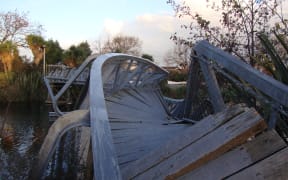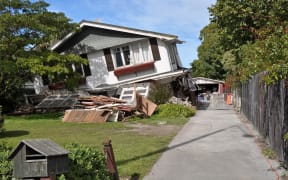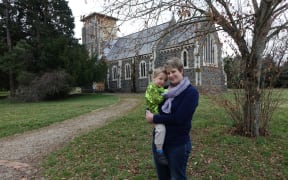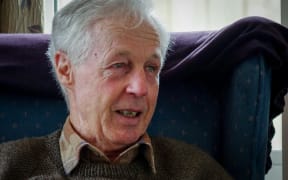It is billed as the earthquake that started it all.
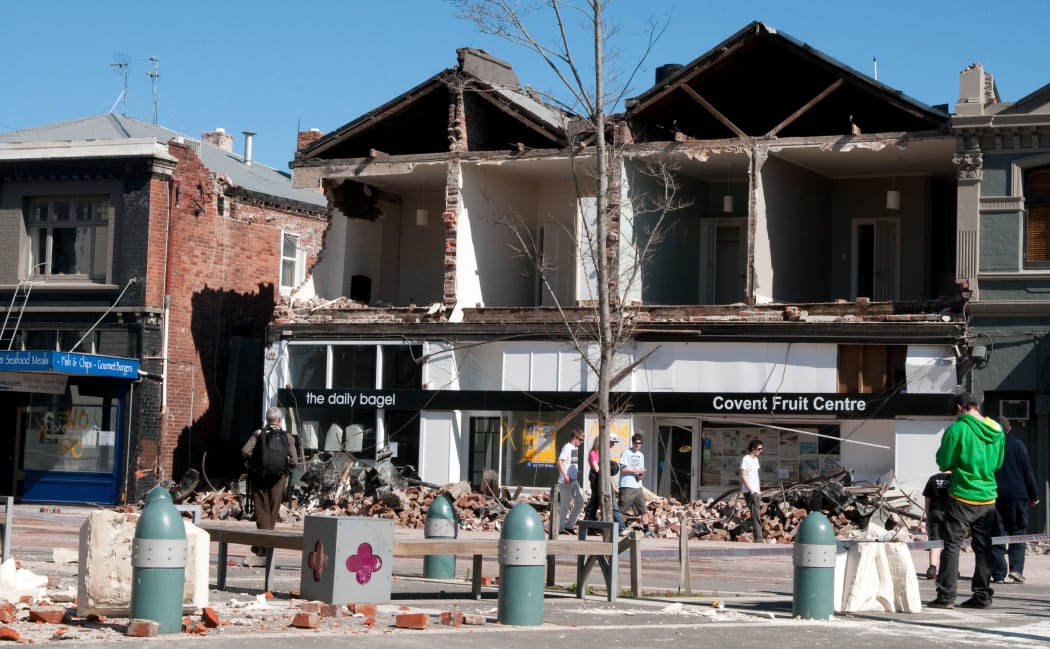
The day after Canterbury was rocked by the 7.1 earthquake on 4 September 2010. Photo: AFP
It was 4 September 2010, and Canterbury was set to wake up to a sunny spring day. Saturday sport and socialising were on the agenda for many people.
But before the sun had a chance to rise, the ground shook.
At 4.35am, the earthquake, measuring 7.1 on the Richter scale, sent a ripple through Canterbury and beyond.
Today marks a decade since the powerful quake which triggered a series of aftershocks, one of which would end up claiming 185 lives in Christchurch five months later.
The epicentre was about 40km west of Christchurch and 10km south-east of Darfield, near Charing Cross, at a depth of 11km.
It would result in 156,619 insurance claims according to the Earthquake Commission, costing $2.487 billion. Of those, EQC said 276 claims relating to the September 2010 event were still open as of this week.
Speaking to RNZ, former Christchurch mayor Sir Bob Parker recalled that day.
"My wife Jo had just come downstairs - and we live in a warehouse - she had come down to make a cup of tea, for some reason, like many people, we had woken up early," he said.
Parker was elected as the city's mayor in 2007 and prior to that he was the mayor of Banks Peninsula, until it amalgamated with Christchurch City Council in 2006.
"I turned the radio on and just as I went to turn the radio on, the room began to shake," Parker said.
"I thought, 'oh it's just one of those little earthquakes we get now and again'. But it kept on shaking, and it just got more and more violent and then things started to fall over in the room and then it really hit," he said.
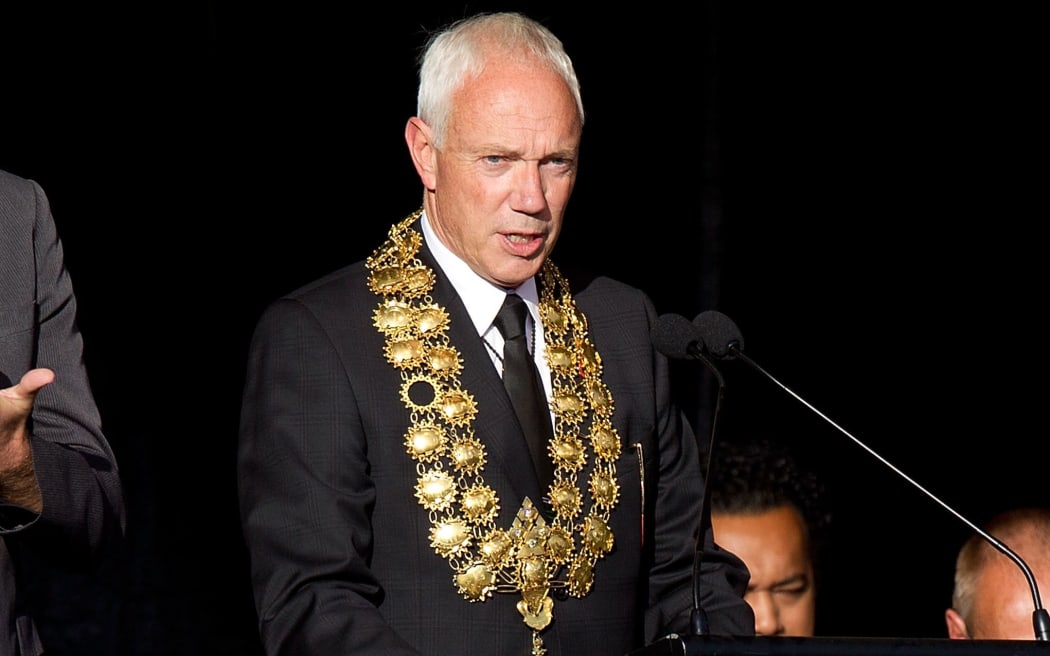
Sir Bob Parker speaking, as mayor, during a remembrance service in Latimer Square in Christchurch on 22 February 2012, one year after the 6.3 quake hit the city killing 185 people and causing tremendous damage. Photo: AFP
The shaking would last for roughly 40 seconds.
"The noise was unbelievable, the building was shaking, I'm upstairs, Jo is downstairs and I'm shouting 'Jo, get out of the building! Get outside!' And she thought I was saying come upstairs for some weird reason, it was noisy," Parker said.
Not long after the shaking stopped, Parker headed to the council offices.
"I remember one of the first things that happened was one of our civil defence people came in and said; 'there's no whiteboards! There are no whiteboards man, what are we going to do? What are we going to write on?'," he said.
"And I said, 'grab a felt tip and write on the wall, this is an emergency, you can do that kind of stuff'," Parker said.
The September earthquake would end up causing significant damage, but crucially, there were no fatalities.
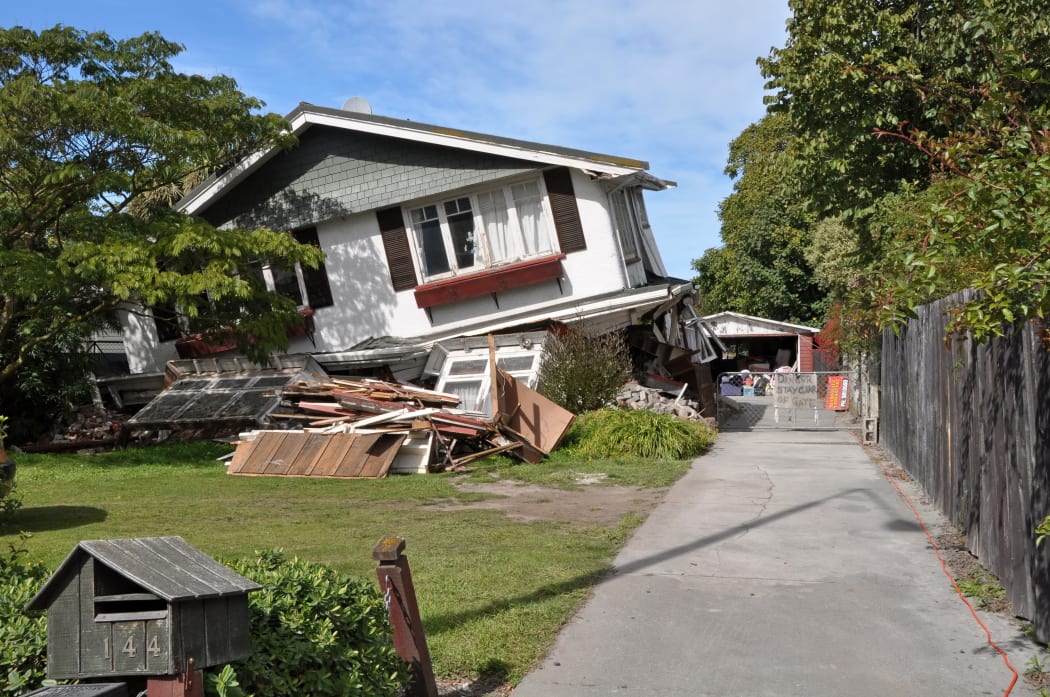
A house in the Christchurch suburb of Avonside which was damaged in the later more deadly quake on 22 February 2011. Photo: 123RF
"We were kind of relieved in a way, because we thought; that's the big one that we've been waiting for, for years, and nobody has died that we know of, there's a few injuries, this is manageable, how lucky we are," Parker said.
He said the feeling of relief was echoed back to the city's leaders.
"If only we knew that was the beginning of what would be two years of violence in the city," Parker said.
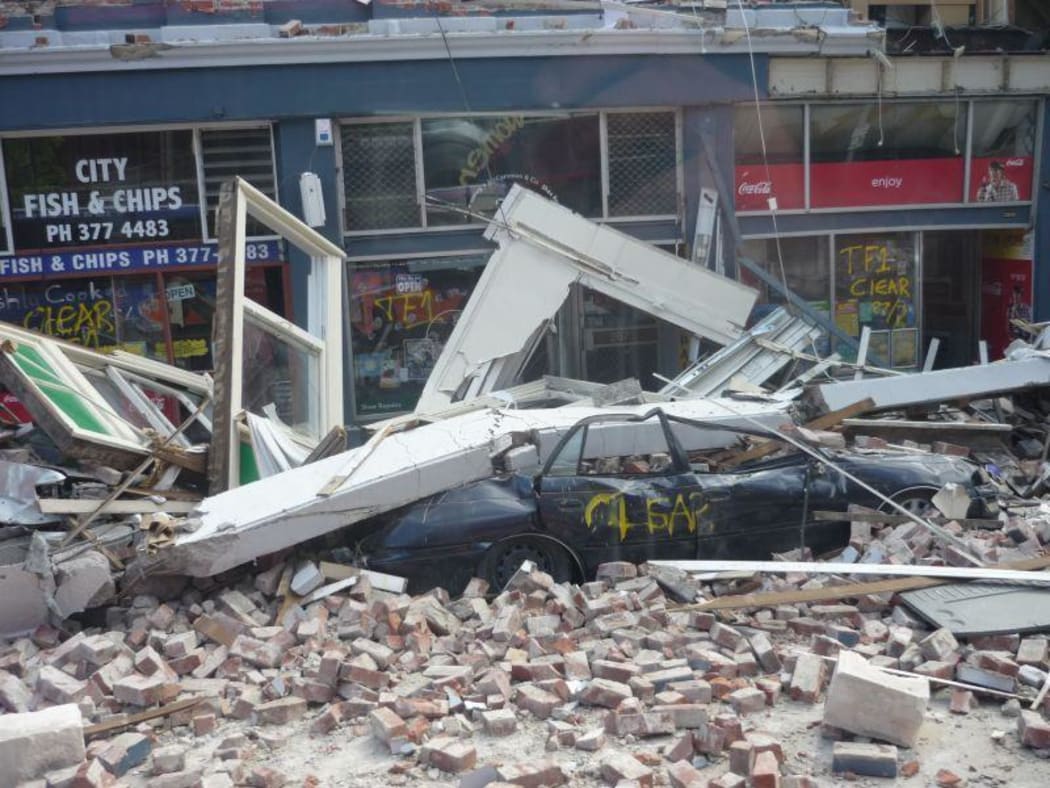
Damage caused during the later quake on 22 February 2011 that hit Christchurch. Photo: RNZ / Simon Morton
The beginning of thousands of aftershocks
After 4 September 2010 Christchurch recorded more than 11,000 aftershocks.
Associate Professor Mark Quigley, from the University of Melbourne's School of Earth Sciences, has extensively studied the Canterbury earthquakes.
"We now know that the Darfield earthquake was sourced from the rupture of probably seven or eight different faults," he said.
"It initiated at the junction of two faults, the Charing Cross Fault South, and Charing Cross Fault North, right near the small area of Charing Cross in the Canterbury Plains."
Dr Quigley said the faults were deep and known as blind faults, meaning they "didn't generate a discreet surface rupture".
"That rupture cascaded from those steep faults onto the Greendale Fault and that's the one that people typically think of when they think of the Darfield earthquake," he said.
The Greendale Fault had what Dr Quigley described as a "big, beautiful surface rupture", through the paddocks in Canterbury.
Prior to 2010, not much was known about the faults which caused the 7.1 earthquake.
"The faults themselves were not imaged with enough accuracy or precision to really tell us much about the structural geometry of the faults in that specific area," Dr Quigley said.
He said to the north and south of the epicentre in the Canterbury Plains, faults had been studied more extensively and understood.
"So it was never a surprise that there was a big complicated fault system beneath the Canterbury Plains where that Greendale Fault system ultimately showed itself to be," Dr Quigley said.
"There was a lot of discussion about this being a new fault when it emerged. [However] it wasn't a new fault, it's an inherited fault, in fact, some of those faults were probably formed 80 million years ago."
Dr Quigley said what had happened was, the penultimate earthquake on the Greendale Fault did rupture the surface but it was buried by alluvial gravels coming out of the Southern Alps and washing out onto the Canterbury Plains.
"So there was no real evidence of a previous fault rupture prior to the 2010 Darfield earthquake there," he said.
Research has also uncovered why the earthquake triggered a significant number of aftershocks.
"We now know that this area was under incredibly high stress and was densely populated by small, structurally complicated faults that were very heavily loaded prior to the commencement of this earthquake sequence," Dr Quigley said.
"So in a sense, they were dominoes waiting to fall."
However, the good news for Cantabrians is that due to the high stress release from the earthquake in 2010, it means that chances of another big one from the area is now low.
"We do not see many aftershocks at all in that area anymore, [aside from] very small ones and very infrequent ones," Dr Quigley said.
He said "from a risk point of view", living near the epicentre of the 2010 event presents no greater risk than living in other parts of New Zealand.
Proud of the response
Looking back at the earthquake response, Sir Bob Parker has no regrets over how it played out.
Sir Bob acknowledged it was a controversial time.
"The city had a lot on its plate because there were some significant buildings that were damaged, and you're caught between the desire of those who believe that those buildings could be saved and strengthened and rebuilt, and those who believe that they really weren't worth trying to save," he said.
Sir Bob said the demolition of the historic Manchester Courts was "perhaps the most controversial".
He said the call to demolish the high-rise, which was built in 1906, was a "tough decision" the council had to make.
Asked whether it was the right decision, Sir Bob stood by it.
"I think it probably was [the right decision], we didn't know what was coming and if it had been left standing, I have no doubt that it probably would have been an even more severe outcome," he said.
Despite the controversy around the time, Sir Bob said he was proud of the response.
He said the biggest lesson from that time was around communication.
"I can remember getting quite a bit of criticism because there were numerous organisations and individuals giving information."
He said "it became clear" that a single channel of communication was needed as often as possible, and said those lessons proved valuable during the deadly 22 February 2011 earthquake.
"But you know, it's like Covid-19, this has never happened before and every decision that you make is a new decision, there's not a lot of precedent," he said.
"Hindsight is 20/20 and plenty of people have been able to tell us what we should have done, but my word, they were not the people in the corner, making the decisions at the time and there's a world of difference."
Sir Bob said he was proud of the people that he worked with.
"Nobody had been exposed to what we were exposed to in Christchurch, we didn't know it on September 4, but we really knew it on February 22 the following year," he said.
"From our point of view, I think that we all did the best that we could in an unknown space and I'm very proud of what our community did and our frontline people, all the emergency services and all those people that came to help us."
Lighting up to remember
Both Christchurch and Darfield are lighting up to mark a decade on from the 2010 earthquake.
The Christchurch City Council and Selwyn District Council had originally planned events to remember the day, but Covid-19 restrictions have meant those plans had to be cast aside.
"Instead we are going to acknowledge the anniversary by lighting up some of the city's landmarks in green - a colour that is associated with growth and renewal," the council's civic and international relations manager Matt Nichols said earlier this week.
"Anniversaries give rise to reflection. As we approach the 10th anniversary of the September 4 earthquake we know that people will reflect on what was lost. But we also hope that people will reflect on how the brave and caring residents of our city have supported each other, and on all that has been achieved since then,'' Nichols said.
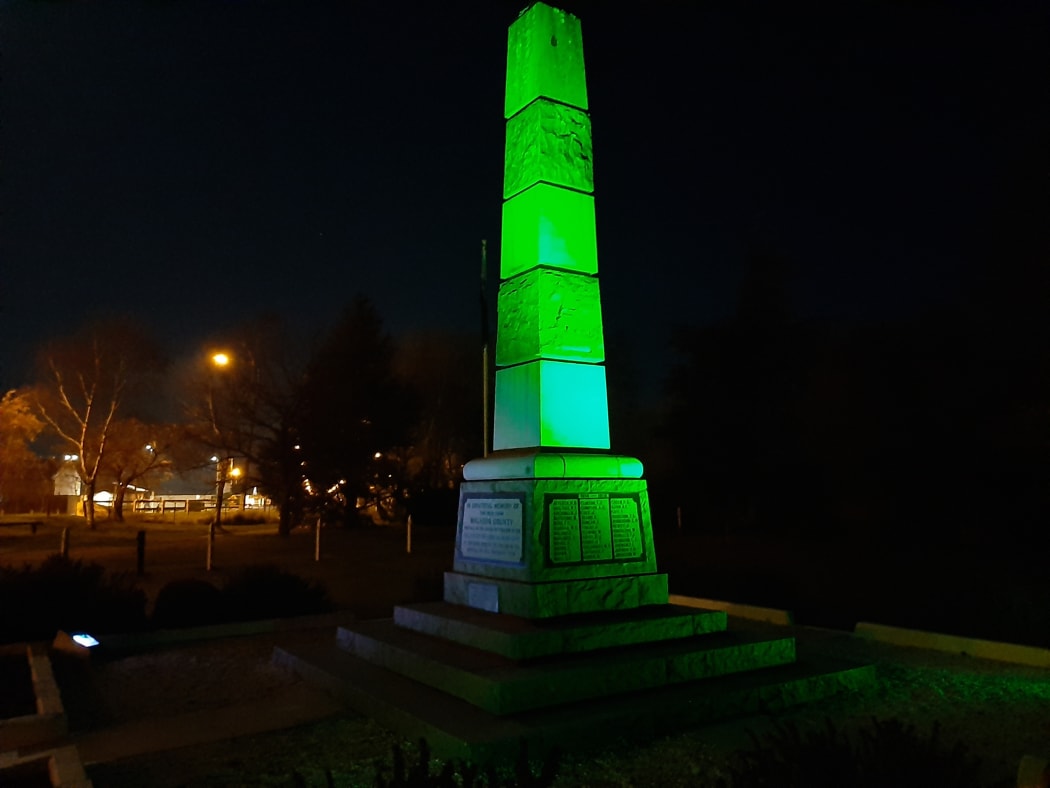
The Darfield War Memorial was last night lit in green ahead of the 10 year anniversary of the 7.2 magnitude earthquake. Photo: Supplied / Selwyn District Council
Closer to the epicentre in Darfield, the town's war memorial is being lit up in green to remember the day.
Selwyn District Mayor Sam Broughton said while many visible signs of the earthquake are gone, the impact remains.
"You only need to scratch the surface in conversation with Selwyn residents and others across Canterbury to realise that damage done in those 40 seconds has etched itself in to the memories of all those that were jolted awake that morning," Broughton said.
"While nobody died, many thousands of us faced a massive clean-up and the job of rebuilding our homes and businesses, and for some an even longer process of psychological recovery - all the while being hit by multiple aftershocks, and living in constant fear of a follow on large shake."
Broughton said commemoration was an important part of healing and growing but also of learning lessons, some of which are especially relevant today.

